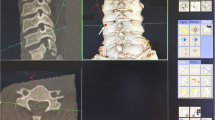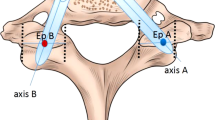Abstract
Study design
Radiographic comparative study with prospectively collected data.
Objectives
To assess the accuracy of subaxial cervical pedicle screw (CPS) placement with freehand technique compared to lateral mass screws (LMS).
Summary of background data
The freehand cervical pedicle screw insertion technique guided by intraoperative lateral C-arm imaging has been shown to be both safe and effective. However, no study has performed a 100% audit of this technique using pre- and postoperative computed tomography (CT) to determine its true accuracy, as well as its reduction capability of CPS and LMS instrumentation.
Methods
36 consecutive patients treated surgically by a single surgeon with the exclusive practice of LMS and subsequently CPS over 2 years were included. CT and EOS slot scanner were performed pre- and post-operatively to determine the extent of pedicle screw breach and to assess sagittal alignment reduction between CPS and LMS groups. Predictors of pedicle screw breaches were also identified using multivariate analysis.
Results
CPS fixation was more effective in restoring global cervical angle and had superior reduction capability of cervical lordosis at the levels of C3/4 (5.00 ± 3.92, p = 0.008), C4/5 (6.63 ± 5.5, p = 0.010) and C5/6 (7.22 ± 6.19, p = 0.004) compared to LMS fixation. Pedicle screw breaches occurred most commonly at C4 (p = 0.003), and most commonly involved the lateral pedicle wall (p < 0.001). Placement of freehand pedicles screws on the concavity of rotated vertebrae was predictive of pedicle screw breach (OR 2.567, 95% CI 1.058–6.228, p = 0.037). There was no significant difference in the complication rate.
Conclusions
Although freehand cervical pedicle screw fixation is technically more demanding, it is generally safe and effective. However, the increased risk of screw breaches in the context of a rotated spine should be taken into consideration. Lateral mass screw fixation is advised if spinal realignment is not necessary.




Similar content being viewed by others
References
Abumi K, Ito M, Sudo H (2012) Reconstruction of the subaxial cervical spine using pedicle screw instrumentation. Spine 37(5):E349–E356. https://doi.org/10.1097/BRS.0b013e318239cf1f
Wang Y, Xie J, Yang Z, Zhao Z, Zhang Y, Li T, Liu L (2013) Computed tomography assessment of lateral pedicle wall perforation by free-hand subaxial cervical pedicle screw placement. Arch Orthop Trauma Surg 133(7):901–909. https://doi.org/10.1007/s00402-013-1752-3
Joaquim AF, Mudo ML, Tan LA, Riew KD (2018) Posterior subaxial cervical spine screw fixation: a review of techniques. Glob Spine J 8(7):751–760. https://doi.org/10.1177/2192568218759940
Perna F, Borghi R, Pilla F, Stefanini N, Mazzotti A, Chehrassan M (2016) Pedicle screw insertion techniques: an update and review of the literature. Musculoskelet Surg 100(3):165–169. https://doi.org/10.1007/s12306-016-0438-8
Yukawa Y, Kato F, Ito K, Horie Y, Hida T, Nakashima H, Machino M (2009) Placement and complications of cervical pedicle screws in 144 cervical trauma patients using pedicle axis view techniques by fluoroscope. Eur Spine J 18(9):1293–1299. https://doi.org/10.1007/s00586-009-1032-7
Uchida K, Nakajima H, Sato R, Yayama T, Mwaka ES, Kobayashi S, Baba H (2009) Cervical spondylotic myelopathy associated with kyphosis or sagittal sigmoid alignment: outcome after anterior or posterior decompression. J Neurosurg Spine 11(5):521–528. https://doi.org/10.3171/2009.2.Spine08385
Law MD Jr, Bernhardt M, White AA 3rd (1993) Cervical spondylotic myelopathy: a review of surgical indications and decision making. Yale J Biol Med 66(3):165–177
Saito J, Maki S, Kamiya K, Furuya T, Inada T, Ota M, Iijima Y, Takahashi K, Yamazaki M, Aramomi M, Mannoji C, Koda M (2016) Outcome of posterior decompression with instrumented fusion surgery for K-line (-) cervical ossification of the longitudinal ligament. J Clin Neurosci 32:57–60. https://doi.org/10.1016/j.jocn.2015.12.050
Abumi KMD, Kaneda KMD (1997) Pedicle screw fixation for nontraumatic lesions of the cervical spine. Spine 22(16):1853–1863
Hey HWD, Tan KA, Ho VC, Azhar SB, Lim JL, Liu GK, Wong HK (2018) Radiologically defining horizontal gaze using EOS imaging-a prospective study of healthy subjects and a retrospective audit. Spine J 18(6):954–961. https://doi.org/10.1016/j.spinee.2017.10.007
Legaye J, Duval-Beaupere G, Hecquet J, Marty C (1998) Pelvic incidence: a fundamental pelvic parameter for three-dimensional regulation of spinal sagittal curves. Eur Spine J 7(2):99–103
Aoude AA, Fortin M, Figueiredo R, Jarzem P, Ouellet J, Weber MH (2015) Methods to determine pedicle screw placement accuracy in spine surgery: a systematic review. Eur Spine J 24(5):990–1004. https://doi.org/10.1007/s00586-015-3853-x
Bredow J, Beyer F, Oppermann J, Kraus B, Meyer C, Stein G, Eysel P, Koy T (2016) A novel classification of screw placement accuracy in the cervical spine. Technol Health Care 24(6):919–925. https://doi.org/10.3233/thc-161246
Lam GC, Hill DL, Le LH, Raso JV, Lou EH (2008) Vertebral rotation measurement: a summary and comparison of common radiographic and CT methods. Scoliosis 3:16. https://doi.org/10.1186/1748-7161-3-16
Min WK, Na SB, Jang JA (2018) Accuracy of thoracic pedicle screw placement using freehand technique and triggered EMG in adolescent idiopathic scoliosis: is it different between concave and convex side? J Orthop Surg 26(2):2309499018784975. https://doi.org/10.1177/2309499018784975
Boon Tow BP, Yue WM, Srivastava A, Lai JM, Guo CM, Wearn Peng BC, Chen JL, Yew AK, Seng C, Tan SB (2015) Does navigation improve accuracy of placement of pedicle screws in single-level lumbar degenerative spondylolisthesis?: a comparison between free-hand and three-dimensional O-arm navigation techniques. J Spinal Disord Tech 28(8):E472–E477. https://doi.org/10.1097/BSD.0b013e3182a9435e
Luo J, Wu C, Huang Z, Pan Z, Li Z, Zhong J, Chen Y, Han Z, Cao K (2017) The accuracy of the lateral vertebral notch-referred pedicle screw insertion technique in subaxial cervical spine: a human cadaver study. Arch Orthop Trauma Surg 137(4):517–522. https://doi.org/10.1007/s00402-017-2647-5
Duff J, Hussain MM, Klocke N, Harris JA, Yandamuri SS, Bobinski L, Daniel RT, Bucklen BS (2018) Does pedicle screw fixation of the subaxial cervical spine provide adequate stabilization in a multilevel vertebral body fracture model? An in vitro biomechanical study. Clin Biomech 53:72–78. https://doi.org/10.1016/j.clinbiomech.2018.02.009
Yukawa Y, Kato F, Yoshihara H, Yanase M, Ito K (2006) Cervical pedicle screw fixation in 100 cases of unstable cervical injuries: pedicle axis views obtained using fluoroscopy. J Neurosurg Spine 5(6):488–493. https://doi.org/10.3171/spi.2006.5.6.488
Westermann L, Spemes C, Eysel P, Simons M, Scheyerer MJ, Siewe J, Baschera D (2018) Computer tomography-based morphometric analysis of the cervical spine pedicles C3–C7. Acta Neurochir 160(4):863–871. https://doi.org/10.1007/s00701-018-3481-4
Chanplakorn P, Kraiwattanapong C, Aroonjarattham K, Leelapattana P, Keorochana G, Jaovisidha S, Wajanavisit W (2014) Morphometric evaluation of subaxial cervical spine using multi-detector computerized tomography (MD-CT) scan: the consideration for cervical pedicle screws fixation. BMC Musculoskelet Disord 15:125. https://doi.org/10.1186/1471-2474-15-125
Kim MK, Cho HJ, Kwak DS, You SH (2018) Characteristics of regional bone quality in cervical vertebrae considering BMD: determining a safe trajectory for cervical pedicle screw fixation. J Orthop Res 36(1):217–223. https://doi.org/10.1002/jor.23633
Pijpker PAJ, Kraeima J, Witjes MJH, Oterdoom DLM, Coppes MH, Groen RJM, Kuijlen JMA (2019) Accuracy assessment of pedicle and lateral mass screw insertion assisted by customized 3D-printed drill guides: a human cadaver study. Oper Neurosurg 16(1):94–102. https://doi.org/10.1093/ons/opy060
Chachan S, Bin Abd Razak HR, Loo WL, Allen JC, Shree Kumar D (2018) Cervical pedicle screw instrumentation is more reliable with O-arm-based 3D navigation: analysis of cervical pedicle screw placement accuracy with O-arm-based 3D navigation. Eur Spine J 27(11):2729–2736. https://doi.org/10.1007/s00586-018-5585-1
Verma R, Krishan S, Haendlmayer K, Mohsen A (2010) Functional outcome of computer-assisted spinal pedicle screw placement: a systematic review and meta-analysis of 23 studies including 5992 pedicle screws. Eur Spine J 19(3):370–375. https://doi.org/10.1007/s00586-009-1258-4
Funding
No funding was received for this work.
Author information
Authors and Affiliations
Contributions
HWDH: substantial contributions to the conception or design of the work, revising critically for important intellectual content, final approval of the version to be published; W-HZ: acquisition of data for the work, Analysis, or interpretation of data for the work, drafting the work, final approval of the version to be published; YHJT: acquisition of data for the work, revising critically for important intellectual content, final approval of the version to be published; JHT: analysis, or interpretation of data for the work, revising critically for important intellectual content, final approval of the version to be published.
Corresponding author
Ethics declarations
Conflict of interest
The authors declare that they have no conflict of interest.
Ethical approval
All procedures performed in studies involving human participants were in accordance with the ethical standards of the institutional and/or national research committee and with the 1964 Helsinki Declaration and its later amendments or comparable ethical standards.
Additional information
Publisher's Note
Springer Nature remains neutral with regard to jurisdictional claims in published maps and institutional affiliations.
Wen-Hai Zhuo: joint first author.
Rights and permissions
About this article
Cite this article
Hey, H.W.D., Zhuo, WH., Tan, Y.H.J. et al. Accuracy of freehand pedicle screws versus lateral mass screws in the subaxial cervical spine. Spine Deform 8, 1049–1058 (2020). https://doi.org/10.1007/s43390-020-00119-z
Received:
Accepted:
Published:
Issue Date:
DOI: https://doi.org/10.1007/s43390-020-00119-z




